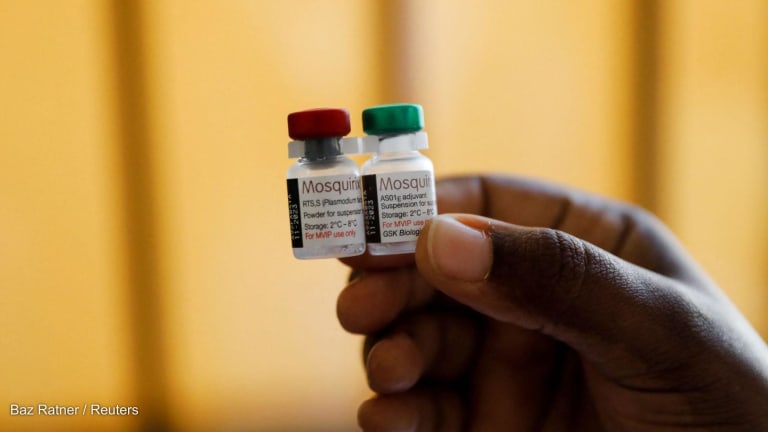
Progress on efforts to reach global malaria targets continue to flatline, according to the World Health Organization’s annual World Malaria Report. An estimated 627,000 people globally died last year from malaria — the highest figure in nearly a decade. Six countries from the African continent accounted for over half of global malaria deaths.
Sign up for Devex CheckUp
The must-read weekly newsletter for exclusive global health news and insider insights.
“We're off track. We are plateauing. Funding is flatlining — and thus, we are seeing no substantial further progress,” Dr. Pedro Alonso, director of WHO’s Global Malaria Programme, told Devex. “We are badly off track and time is running out.”
The global goals include a 90% reduction in incidence and mortality rates by 2030 from baseline levels in 2015.
The agency started warning the world it is off track to meeting targets since 2017. Last year, the malaria case incidence was 59 cases per 1,000 people, whereas the target for last year was 35 cases. The death rate was 15.3 deaths per 100,000 people at risk, whereas the target was 8.9 people. Overall, compared to 2019, there were an additional 14 million cases and an additional 69,000 deaths.
Gavi decides to fund the rollout of world's first malaria vaccine
But a lingering challenge remains: a massive scale-up in production.
According to WHO, most countries with a high burden of the disease have experienced setbacks and are losing ground in reaching targets. Since 2015, 32 countries have seen increases in the incidence of cases and 24 have seen increases in mortality rates.
Eleven countries carry 70% of the world’s malaria burden: Burkina Faso, Cameroon, Democratic Republic of the Congo, Ghana, India, Mali, Mozambique, Niger, Nigeria, Uganda, and Tanzania. In these countries, malaria deaths increased from 390,000 in 2015 to 444,600 last year.
“This should provoke a rethinking — just going on doing the same thing over and over again and expecting a different result is what Einstein called insanity,” Alonso said.
While $3.3 billion was invested globally in control and elimination efforts last year, the goal was to reach $6.8 billion.
“We are now at a critical juncture, and I urge global leaders for renewed commitment and investment,” said Dr. Abdourahmane Diallo, CEO at the RBM Partnership to End Malaria, in an emailed statement.
The global malaria community received good news last week when Gavi committed $155.7 million in funding to roll out the world’s first malaria vaccine RTS,S in sub-Saharan Africa through 2025. The vaccine, if properly deployed, could save between 40,000 and 80,000 lives every year, Alonso said, adding that beyond this, there is a need for the continued development of improved vaccines, vector control options, diagnostics and treatments.
And above all, Alonso said, countries need to take ownership over national responses, with international funding mechanisms aligning to support this ownership, as well as an increase in national budgets towards funding the fight. Countries also need to be more flexible and adapt different approaches to cater to the various realities of the malaria burden within their borders.
“The intensity of transmission; the age groups that are affected; the access to diagnosis and treatment; the access to prevention tools — all of this changes pretty drastically, I dare say, in every single country,” he said.
The report also introduced an improved statistical methodological tool that says the burden of malaria has been underestimated. Malaria accounts for 7.8% of deaths of children under 5, whereas it was previously believed to account for 4.8% of deaths.
“For those of us that have been around for a long time, we always suspected that malaria is a bigger problem than what may have been estimated in the past,” Alonso said.
But it hasn’t been all bad news. This year, China, the largest malaria endemic country, was certified malaria-free.
“It’s a country that used to have up to 30 million cases every year, that's more than what the Democratic Republic of Congo has now. So that's a great success story,” he said.
And there had also been concerns around antimalarial drug resistance in the greater Mekong subregion spreading globally in recent years.
“Those threats never materialized,” he said. “We have seen extraordinary progress over the last six, seven years. And I think it's very fair to say that we are within months or a couple of years of seeing malaria entirely eliminated from that part of the world. And of course, drug resistance never spilled out of Southeast Asia.”
And the doomsday predictions of what might happen to malaria management during the COVID-19 pandemic didn’t come to fruition. WHO predicted early in the pandemic that, in a worst case scenario, malaria deaths could double in sub-Saharan Africa. But despite disruptions, 72% of insecticide-treated net-distribution programmes moved forward last year.
But still, additional lives were lost. According to the report, there were an estimated 47,000 additional malaria deaths because of disruptions to the prevention, diagnostic, and treatment efforts due to the pandemic last year — a 12% increase in deaths.









